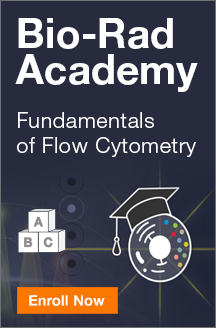-
US | en

Autofluorescence
Cells have a natural level of fluorescence, called autofluorescence, which can be a problem in flow cytometry data analysis. Cellular autofluorescence can be due to the presence of collagen and elastin, cyclic ring compounds such as NADPH and riboflavin, aromatic amino acids and cellular organelles such as mitochondria and lysosomes. The level in cells can vary due to variances in the levels of these cellular compounds and organelles that give rise to the fluorescence. In general, larger cells and more granular cells have increased autofluorescence due to an increase in the number of fluorescent compounds.
Autofluorescence Wavelengths
Most autofluorescence is detected at shorter light wavelengths with most absorbing at 350-500 nm and emitting at 350-550 nm. This is especially true for mammalian cells, which contain many compounds that excite by the 488 nm laser and emit in the FITC range. Autofluorescence can therefore be a problem in these light ranges as the signal to noise ratio is decreased resulting in reduced sensitivity and false positives. In addition autofluorescence spillover into another channel can mask low expressers.
The level of autofluorescence can be determined using unstained controls. As there is less autofluorescence at longer light wavelengths, fluorophores which emit above 600 nm will have less autofluorescence interference. The use of a very bright fluorophore will also reduce the impact of autofluorescence.

Fig. 23. Autofluorescence. Natural levels of autofluorescence can vary between different cells types. Lymphocytes (red) have less fluorescence than granulocytes (blue).
